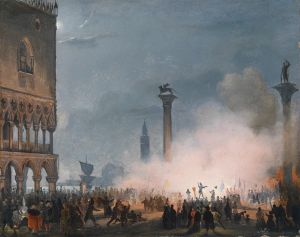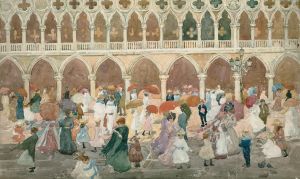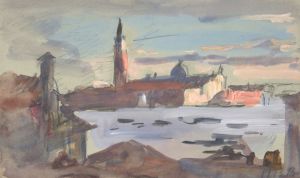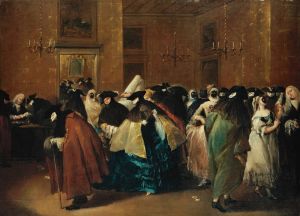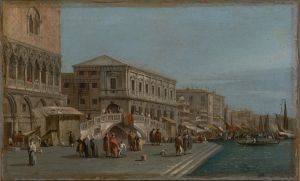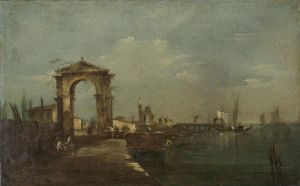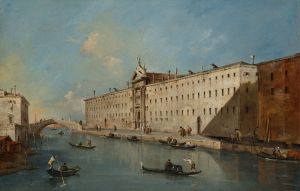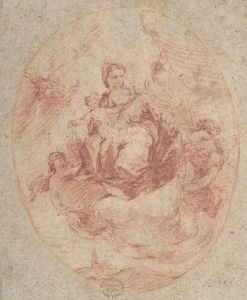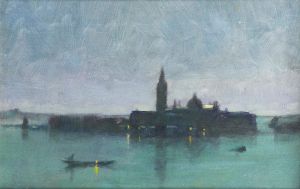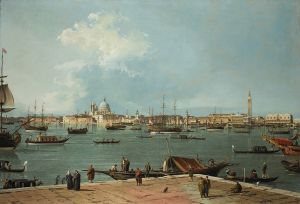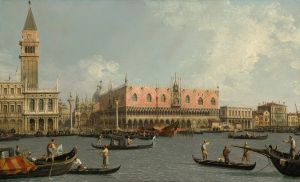
Venice, the Piazzetta looking south, with a view of the Doge’s Palace and the Biblioteca Marciana, the island of San Giorgio Maggiore beyond
A hand-painted replica of Francesco Guardi’s masterpiece Venice, the Piazzetta looking south, with a view of the Doge’s Palace and the Biblioteca Marciana, the island of San Giorgio Maggiore beyond, meticulously crafted by professional artists to capture the true essence of the original. Each piece is created with museum-quality canvas and rare mineral pigments, carefully painted by experienced artists with delicate brushstrokes and rich, layered colors to perfectly recreate the texture of the original artwork. Unlike machine-printed reproductions, this hand-painted version brings the painting to life, infused with the artist’s emotions and skill in every stroke. Whether for personal collection or home decoration, it instantly elevates the artistic atmosphere of any space.
"Venice, the Piazzetta looking south, with a view of the Doge’s Palace and the Biblioteca Marciana, the island of San Giorgio Maggiore beyond" is a painting by the renowned Italian artist Francesco Guardi. Guardi, born in Venice in 1712, was a prominent figure in the Venetian school of painting and is best known for his vedute, or detailed cityscapes, which capture the essence and atmosphere of 18th-century Venice.
This particular painting is a quintessential example of Guardi's work, showcasing his ability to depict the grandeur and beauty of Venice with a remarkable sense of light and perspective. The painting portrays the Piazzetta, a small extension of the Piazza San Marco, looking southward. In the foreground, the viewer can see the Doge’s Palace (Palazzo Ducale) on the left, an iconic Gothic structure that served as the residence of the Doge of Venice, the supreme authority of the former Venetian Republic. The palace is characterized by its intricate façade and the distinctive arches and columns that are emblematic of Venetian Gothic architecture.
To the right of the Doge’s Palace stands the Biblioteca Marciana, also known as the Library of Saint Mark. This Renaissance building, designed by Jacopo Sansovino, houses one of the most significant collections of classical texts in the world. Its elegant and harmonious design complements the Gothic style of the Doge’s Palace, creating a visually striking contrast that is a hallmark of Venetian architecture.
In the background of the painting, across the waters of the Venetian Lagoon, lies the island of San Giorgio Maggiore. The island is dominated by the Church of San Giorgio Maggiore, a masterpiece of Renaissance architecture designed by Andrea Palladio. The church's classical façade and towering campanile (bell tower) are prominent features that add depth and a sense of scale to the composition.
Francesco Guardi's technique in this painting is notable for its loose, expressive brushwork and the use of light to create a luminous, almost ethereal quality. This approach helps to convey the shimmering reflections on the water and the play of light on the architectural surfaces, capturing the unique atmosphere of Venice. Guardi's ability to render the effects of light and atmosphere with such skill and sensitivity is one of the reasons he is celebrated as one of the great vedutisti, or view painters, of his time.
The painting is a testament to Guardi's deep connection to his native city and his mastery in depicting its iconic landmarks. It serves not only as a beautiful work of art but also as a historical document, offering a glimpse into the splendor of Venice during the 18th century. Today, Guardi's works are highly valued and can be found in major art museums and collections around the world, where they continue to be admired for their artistic excellence and historical significance.






